Edie Melson's Blog, page 15
May 14, 2025
Why I Wrote How to Sell 1,000 Books a Month
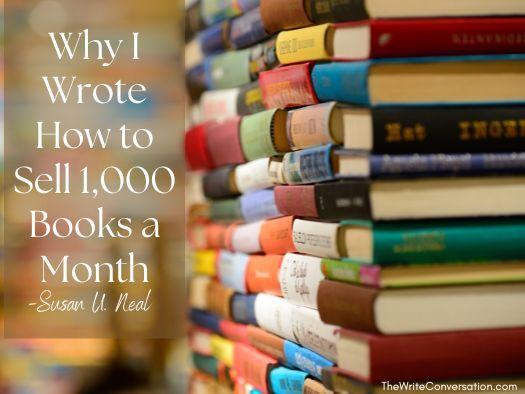
by Susan U. Neal RN, MBA, MHS @SusanNealYoga
When I first began my journey as a Christian author, I had no idea just how much marketing was involved in selling books. Like many writers, I thought my job ended with writing and publishing a great manuscript. But I quickly learned that if you want your message to reach people—and especially if you believe that message is divinely inspired—you must also be willing to promote it.
Over the past several years, I’ve learned how to sell books not just steadily, but successfully. In 2022, I reached a personal milestone for my self-published book 7 Steps to Get Off Sugar and Carbohydrates: the book’s overall Amazon author rank hit 4,400 out of more than 8 million books on Amazon. That placed me in the top 1 percent of all Amazon authors. As an award-winning, best-selling author and certified writer coach, I’ve gained a great deal of insight into what works—and what doesn’t—when it comes to book marketing.
And now I want to share those marketing secrets with you.
That’s why I wrote How to Sell 1,000 Books a Month. I felt called to help other Christian authors share their God-given message with more readers. This book is my response to that calling. It’s a roadmap that combines proven tactics, using scientific methods, that work along with spiritual encouragement. Whether you’re traditionally published or self-published, a first-time author or a seasoned pro, this book will equip you with the tools to expand your reach, boost your sales, and ultimately, fulfill your ministry.
A Proven Path to Book Sales
Marketing can feel overwhelming at first. But with the right plan and a little bit of consistency, you’ll begin to see results. My book breaks down the key components of successful marketing in a practical, step-by-step way.
Here are just a few of the strategies covered in How to Sell 1,000 Books a Month:Identify your target audience and their pain points. Know exactly who you’re writing to and how your book can help or inspire them.Create a compelling lead magnet and email sequence. Building your email list is essential for long-term success.Develop a strong author brand. Your website, headshot, colors, and messaging should reflect your core values and attract your ideal reader.Leverage Amazon ads and keywords. I walk you through how to increase discoverability and visibility with the right search terms.Gain book reviews. Social proof matters. I’ll teach you how to get those first 50 Amazon reviews—and keep them coming. 7 Steps to Get Off Sugar and Carbohydrates has over 1500 Amazon reviews. Use media interviews to build momentum. Learn how to land podcast, radio, and television interviews that generate buzz and sales.Plan an intentional book launch. Every book needs a well-planned book launch. Learn how to obtain that marketing push.Virtual or live events. From summits to workshops to speaking gigs, these opportunities can introduce your book to entirely new audiences.Win awards. Submitting your book for awards brings credibility and increased exposure.Turn your knowledge into digital products or courses. This not only diversifies your income but deepens your reader’s experience. Authors need to make money to support their ministry.
Each chapter offers practical steps, real-life examples, and spiritual encouragement. You’ll also find a marketing plan for you to complete as you read How to Sell 1,000 Books a Month HERE.
A Mission Rooted in Ministry
As Christian writers, we aren’t just selling books—we’re sharing life-changing messages. That’s why I’m passionate about helping authors succeed in their calling. I’ve been where you are—trying to figure out how to gain traction, how to grow an email list, how to find readers who truly need my message. And I’ve learned that when you follow a proven path and invite God into the process, remarkable things happen.
How to Sell 1,000 Books a Month is more than a marketing manual—it’s a ministry tool. It’s written to help you reach the people God intends for you to reach.
If your goal is to get your words into the hands of more readers and make a greater Kingdom impact, I invite you to walk with me through this book. Visit SusanUNeal.com to learn more.
TWEETABLEWhy I Wrote How to Sell 1,000 Books a Month from @SusanNealYoga on @EdieMelson (Click to Tweet)
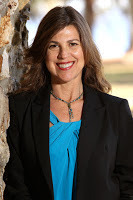 Susan U. Neal, RN, MBA, MHS: Susan’s mission is to improve the health of the body of Christ. She has her RN and MBA degrees, as well as a master’s in health science. She is a CERTIFIED HEALTH AND WELLNESS COACHwith the American Association of Christian Counselors. She published five books, the Selah award winner 7 STEPS TO GET OFF SUGAR AND CARBOHYDRATES, CHRISTIAN STUDY GUIDE FOR 7 STEPS TO GET OFF SUGAR AND CARBOHYDRATES, HEALTHY LIVING JOURNAL, SCRIPTURE YOGAa #1 Amazon best-selling yoga book, and YOGA FOR BEGINNERSwhich ranked #3. She published two sets of Christian Yoga Card Decks and two Christian Yoga DVDs that are available at CHRISTINAYOGA.COM. Her digital product HOW TO PREVENT, IMPROVE, AND REVERSE ALZHEIMER’S AND DEMENTIAis a great resource. To learn more about Susan visit her website SUSANUNEAL.COM You can also connect with Susan on FACEBOOK, TWITTER, and INSTAGRAM.
Susan U. Neal, RN, MBA, MHS: Susan’s mission is to improve the health of the body of Christ. She has her RN and MBA degrees, as well as a master’s in health science. She is a CERTIFIED HEALTH AND WELLNESS COACHwith the American Association of Christian Counselors. She published five books, the Selah award winner 7 STEPS TO GET OFF SUGAR AND CARBOHYDRATES, CHRISTIAN STUDY GUIDE FOR 7 STEPS TO GET OFF SUGAR AND CARBOHYDRATES, HEALTHY LIVING JOURNAL, SCRIPTURE YOGAa #1 Amazon best-selling yoga book, and YOGA FOR BEGINNERSwhich ranked #3. She published two sets of Christian Yoga Card Decks and two Christian Yoga DVDs that are available at CHRISTINAYOGA.COM. Her digital product HOW TO PREVENT, IMPROVE, AND REVERSE ALZHEIMER’S AND DEMENTIAis a great resource. To learn more about Susan visit her website SUSANUNEAL.COM You can also connect with Susan on FACEBOOK, TWITTER, and INSTAGRAM.
Published on May 14, 2025 22:00
May 13, 2025
Publishing As a Second Language—Bio note, Bio, Full Biography—What is the difference?

by Linda Gilden @LindaGilden
When I wrote my first article for a well-known writer’s magazine, the last line of the acceptance letter said, “Please include a bionote with your article.” Bionote? What is that? I had never heard that term before and had to find out exactly what they were asking for.
Definitions and Details for Writing Your Bio
Bio Note: The magazine guidelines said it should be very short - no more than three lines. Three lines is not many words. Also included was this was not the place for education and family news, but for how you are qualified to write the article.
As I researched, I learned exactly what a bionote is. It is, indeed, short. Some publishers count it in lines (around three), others count it in words (100-150). At times it is a matter of space. For instance, if you are writing a one-page article and you are given a certain word count, there is usually not much room for extra words.
Biography: Sometimes this is called “bio” for short. There used to be only one type of biography, and most authors had one bio that they sent with every manuscript. It was a basic short document that included your name, family information, education, and other things. If you sent it in to your publisher, they just cut it down if it exceeds the number of words they need. When they simply ask you to include a biography, send a short bio that can be cut down if needed. Sometimes if they don’t state how many words they’d like, I send a short version and the full bio then they can pick which one they want depending on the space they have.
Full Biography: A full biography usually appears within the back matter of your book. You can include a headshot of yourself, and this usually fits on one page This is where you can pull out all the stops. You can include everything you would like your readers to know about you – education, life experiences, family, hobbies, work. Things that especially relate to your book are good to include. Also, include your contact information or website so they can tact you if desired.
I have found if you tell a short family story or a story about your grandchildren, people will remember it and often it becomes a good conversation starter when you meet in person. One of the things I usually include that is a great conversation starter is the fact that our family has a secret love note—folded potato chips! Hundreds of people have asked me what that is. When our family eats together, you will see the grandchildren quietly leave their chairs and slip a folded potato chip on someone’s plate. I never fuss when I see them doing that because I know what they are doing and it always makes me smile.
Biographies are important because they introduce the reader to the author. Some readers check out the biography first so they are acquainted with the author. So do your best as you introduce yourself to your readers, and you may make a new and faithful reader.
Here’s an example of the last paragraph of my usual biography.
Linda Gilden is a farm wife, mother, and grandmother. If you have another hour or more, she can tell you about the six cutest grandchildren on the planet! Her greatest joy is time spent with her family, where their secret love note is folded potato chips. Her favorite activity is floating in a pool with a good book surrounded by splashing grandchildren! www.lindagilden.com.
CLICK TO TWEETPublishing As a Second Language—Bio note, Bio, Full Biography—What is the difference? From @LindaGilden on @EdieMelson (Click to Tweet)
 Linda Gilden is an award-winning writer, speaker, editor, certified writing and speaking coach, and personality consultant. Her passion is helping others discover the joy of writing. Linda recently released Articles, Articles, Articles!and is the author of over a thousand magazine articles and 17 books including the new LINKED Quick Guides for Personalities. As Director of the Carolina Christian Writers Conference, Linda helps many writers take the next step in reaching their writing goals. Linda’s favorite activity (other than eating folded potato chips) is floating in a pool with a good book surrounded by splashing grandchildren—a great source of writing material! www.lindagilden.com
Linda Gilden is an award-winning writer, speaker, editor, certified writing and speaking coach, and personality consultant. Her passion is helping others discover the joy of writing. Linda recently released Articles, Articles, Articles!and is the author of over a thousand magazine articles and 17 books including the new LINKED Quick Guides for Personalities. As Director of the Carolina Christian Writers Conference, Linda helps many writers take the next step in reaching their writing goals. Linda’s favorite activity (other than eating folded potato chips) is floating in a pool with a good book surrounded by splashing grandchildren—a great source of writing material! www.lindagilden.com
Published on May 13, 2025 22:00
May 12, 2025
A Writers Guide to Conferencing
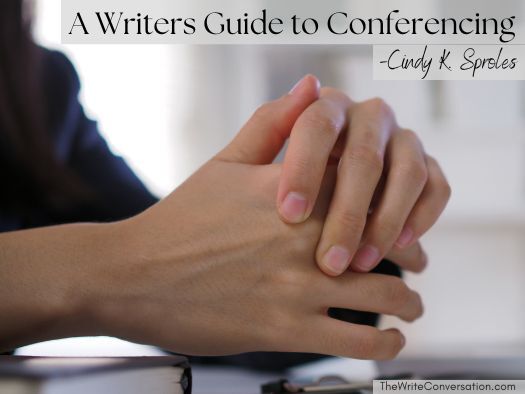
by Cindy Sproles @CindyDevoted
It’s conference time across the country, and that means preparation. I’m embarrassed to admit it, but I’m going to share some things about my first conference ever. The conference was great. Don’t get me wrong. But poor me—so green you couldn’t snap me in half if you tried.
In all fairness to me, I’d never attended a conference before. Not just a writers conference but any conference. You have to remember, I’m a mountain gal, and though I’m not stuffed into the crevice of a mountain fold, I wasn’t exposed to a lot of outside events like conferences. You could say I was naive. So, attending my first conference was a true learning experience.
If I were to suggest how and what to do at a conference, I’d suggest the following things to all writers. As they say, I learned the hard way, but you don’t have to. You can sidestep some mistakes by seeing my blunders. Here we go.
Tips for Attending a Writing Conference
Attending alone: Sometimes, we have buddies who travel alongside us; at other times, we don’t. I didn’t have a buddy, so I had a slight hesitation as I climbed into the car and laid out my Rand-McNally printed directions. (We didn’t have GPS gadgets yet.) A friend by my side would have been nice, and when you add that I’m an introvert, let’s just say I was nervous. Still, my Momma taught me to be a big girl. Straighten your shoulders, take a deep breath, and do it. So, I did. Now, here’s the kicker. My arms were covered in poison ivy. Yep, poison ivy. The doctor had wrapped them in sterile white gause, and you could say, mummy probably fit me to a tee. The itching was unbearable, even with long sleeves to cover the embarrassing bandages. I wondered if anyone would even stand close to me for fear of “getting something.”
I sat on a couch in the hotel lobby and began to people-watch. I quickly learned the questions writers asked one another. “What do you write? Are you published yet? Think I’ll find an agent this time?” I deduced I could ask those questions as well. Again, a buddy would have been nice to help ease the uncomfortable feeling, but I found out rather quickly that writers are friendly and don’t hesitate to talk to any and everyone, whether they know you or not. A sweet lady inched onto the couch beside me, smiled, and said, “I heard folks were itching to get here.” She bumped my shoulder and began to giggle. I immediately saw that writers were friendly. We became friends, even roomed together a couple of conferences later, and when she was nominated for a Christy Award, not once, but twice. It was me she called and invited to sit with her at the ceremony. Attending your first conference alone is scary, but don’t fret. Writers are friendly, and a warm smile invites them like a lit porch light at night. Attending alone is not so bad. In fact, it may be better for you because you are forced to make friends quickly and not hide behind the familiar.
Come prepared: A notebook was an afterthought for me. I started out my door and grabbed a stack of Post-it notes. Let me say Post-it notes are not the ideal note-taking item. Before you judge me, remember, I’d never done anything like this in my life. I was clueless. Go prepared. Be sure you have a notepad, a couple of pens, and a few business cards. Now! About those business cards. They don’t have to be fancy. You can print your own with some help from your local business supply store. Your business card needs to have your name and email address on it. There’s no need to add your home address, but adding your photo is especially helpful. Save those fancy cards for a later date. Folks just want a way to find you and correspond. Make your card simple but professional-looking. You don’t need embossed cards. My point is, don’t fret. Provide what is necessary, and you can upgrade as you grow in the industry.
Learn what a one-sheet is: Again, simple is best. Editors and agents don’t care if you have fancy photos on a one-sheet. It’s to help you pitch. Pitch the story, not the look of the one sheet. Simple, professional, and to the point. Print a few and carry them with you. That’s all you need to begin.
Don’t be pressured by “appointments”: 99.9 percent of first-time writers get the vapors when appointments are offered. They suddenly see folks racing for appointments with agents and publishers to pitch their books. Well, I give you permission to take a breath. Often, writers get things out of order when it comes to appointments. They rush to pitch a story that only has three chapters written or only a pitch (an idea). You don’t need an agent until you have a completed manuscript. An agent cannot sell what you have not written. So, let go of the idea that you must find an agent. Having an agent does zero good until you have a completed manuscript ready to market to publishers. Take that pressure off yourself.
Get your writing life in order: Learn the craft, write a manuscript, find an agent, and let your agent sell your work. That’s the order. It just doesn’t work any other way. However, choose an agent who you’d like to pick their brain. Network. Ask questions, and learn from these folks. Show them your work and ask if you are on track. Get to know these industry professionals because they will become your outlet for publication. Remember, release the idea that you need an agent. Remember the order: learn, write, complete, agent, publication. Use those appointments to network. It’s valuable, and to repeat myself, once you have a completed work, then begin pitching it.
Choose classes “where you are” in your writing track: Conferences offer so many classes, which is wonderful. It’s amazing that so many professionals want to see success among writers, and they put their time and effort into teaching, guiding, and helping those dreams come true. My biggest mistake at my first conference was taking classes way above my current writing skill level. Writing is a craft, and it’s something you must learn in stages because story-building rides on knowing the foundation. If you are a new writer, you must learn the mechanics before you hop on the train to plot development and characterization. A new writer must understand show not tell before they start writing a serious story. They need to grasp dialogue and resisting the urge to overexplain. They need to recognize how to self-edit and what a story arc is.
These are necessary before you move on to the next layer of the craft. So, when you look at classes at a conference, choose classes where your skill level currently stands. Master those, and then move to more advanced classes. Why do I say you should take classes where you are skill-wise? At a conference, you are face-to-face with teachers who can answer your questions and bring things down to a level that makes sense. There are simply things that you only learn by hearing them told to you. They aren’t always written down. Sometimes, you gain the most from the experiences of those who teach. Take classes where you are in your current skill level. And then—pay attention here! Buy the MP3s of the conference. Why? You have the remainder of the classes you did not take in person, and you have them forever. These are your continued education. It’s money well spent and an investment in your future career.
Bottom LineYour first conference, or even your tenth or hundredth, should always be enjoyable. The stress should be gone. You’re there to learn. Let go of previous notions, learn the order of a writing career, and then enjoy your time at the conference. Make industry friends and writing peers, or find a critique group like Word Weavers or a local group near you. Get the hidden benefits from your conference experience by letting go of the stress and unreasonable expectations.
I never want anyone to walk into a conference as green as I was and make the mistakes I made. What I want, and all faculty members wish for our conferees, is to have a successful, well-spent time that stair steps into a remarkable career. Nothing is better than seeing the success of those we’ve walked alongside. Get ready for that conference, and we’ll cheer you on!
CLICK TO TWEETA Writers Guide to Conferencing from @CindyDevoted on @EdieMelson (Click to Tweet)
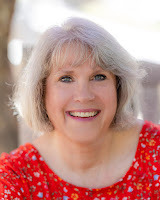 Cindy K. Sproles is an author, speaker, and conference teacher. Having served for a number of years as a managing editor for Lighthouse Publishing of the Carolinas and Ironstream Media, Cindy now works as a mentor, coach, and freelance editor. She is the co-founder of Writing Right Author Mentoring Services with Lori Marett and she is the director of the Asheville Christian Writers Conference. Cindy is also the co-founder of Christian Devotions Ministries and WWW.CHRISTIANDEVOTIONS.US, as well as WWW.INSPIREAFIRE.COM. Her devotions are in newspapers and magazines nationwide, and her novels have become award-winning best-selling works. She is a popular speaker at conferences and a natural encourager. Cindy is a mountain girl, born and raised in the Appalachian mountains, where she and her husband still reside. She has raised four sons and now resorts to raising chickens where the pecking order is easier to manage. You can visit Cindy at WWW.CINDYSPROLES.COM or www.wramsforwriters.com.
Cindy K. Sproles is an author, speaker, and conference teacher. Having served for a number of years as a managing editor for Lighthouse Publishing of the Carolinas and Ironstream Media, Cindy now works as a mentor, coach, and freelance editor. She is the co-founder of Writing Right Author Mentoring Services with Lori Marett and she is the director of the Asheville Christian Writers Conference. Cindy is also the co-founder of Christian Devotions Ministries and WWW.CHRISTIANDEVOTIONS.US, as well as WWW.INSPIREAFIRE.COM. Her devotions are in newspapers and magazines nationwide, and her novels have become award-winning best-selling works. She is a popular speaker at conferences and a natural encourager. Cindy is a mountain girl, born and raised in the Appalachian mountains, where she and her husband still reside. She has raised four sons and now resorts to raising chickens where the pecking order is easier to manage. You can visit Cindy at WWW.CINDYSPROLES.COM or www.wramsforwriters.com.
Published on May 12, 2025 22:00
May 11, 2025
Help to Make Those Writing Deadlines. Deadline. Deadlines.

by Larry J. Leech II @LarryJLeechII
For many, the bane of their existence. But when we make ’em, all is well in the world. We smile, dance, and take a deep breath. But … when we miss one or two or three, we run the risk of being reminded by our editor. Or get publicly admonished.
We work in a deadline-driven industry. When we miss a deadline, we throw a monkey wrench into the process toward publication.
For years two numbers have been repeated over and over in regard to the percentage of projects that miss a deadline. Some have said 90 percent, which certainly is not good. Others have said 99 percent. Yikes!
If you need help making deadlines, consider these three tools that will work for writing a blog, an article, or a manuscript.
Plan. Give yourself plenty of time. If you are new to publishing deadlines, make self-imposed deadlines for each phase of your project. For example, set deadlines for: research (internet, library, book, possibly interviews). writing the first draft, editing, rewrites, second round of edits, and maybe a professional edit. If you can, send it early. Editors love when requested material arrives before deadline.
Execute. Write your first draft without editing. I’ve seen many writers get stuck because they want to edit and edit and edit while they write. James Scott Bell, an award-winning author in the inspirational market, has said for years: “Write hot, edit cold.” Be realistic about how much time you need to write your first draft and subsequent drafts. For instance, an article about a topic you’re not familiar with will take longer to write than a topic you know like the back of your hand.
Communicate. If you will miss a deadline, let the editor know as soon as possible. We understand that life happens. Early communication will help give the editor the opportunity pivot to another story or give you a new deadline that won’t derail publication.
I hope these tips help you land in the one to ten percent of writers who make deadline. If you have a tool that has helped you, feel free to include in the comments.
Happy writing and rewriting. And making your deadline.
Click to TweetHelp to Make Those Writing Deadlines. Deadlines. Deadlines. from @LarryJLeechII on @EdieMelson (Click to Tweet)
 Usually with a hot beverage nearby, Larry J. Leech II spends his days working with words—as a writing coach of award-winning authors, as well as Acquisitions Editor and Master Book Coach for Illumify Media. More than forty years ago, Larry started his career as a sportswriter in southwestern Pennsylvania where he covered prep sports, college sports, and the Pittsburgh Pirates and Steelers. In 2004, after 2,300 published articles, Larry shifted to book publishing. Since that time, he has ghostwritten thirty books, edited more than 450 manuscripts, and coached hundreds of authors through the writing and publication process. For nearly two decades Larry has taught at numerous general market and inspirational conferences nationwide. When he has a minute, Larry likes to hang out on Facebook and Instagram. You can also find out more about him on his website: larryleech.com.
Usually with a hot beverage nearby, Larry J. Leech II spends his days working with words—as a writing coach of award-winning authors, as well as Acquisitions Editor and Master Book Coach for Illumify Media. More than forty years ago, Larry started his career as a sportswriter in southwestern Pennsylvania where he covered prep sports, college sports, and the Pittsburgh Pirates and Steelers. In 2004, after 2,300 published articles, Larry shifted to book publishing. Since that time, he has ghostwritten thirty books, edited more than 450 manuscripts, and coached hundreds of authors through the writing and publication process. For nearly two decades Larry has taught at numerous general market and inspirational conferences nationwide. When he has a minute, Larry likes to hang out on Facebook and Instagram. You can also find out more about him on his website: larryleech.com.
Published on May 11, 2025 22:00
May 10, 2025
Optimizing Writing for the Web
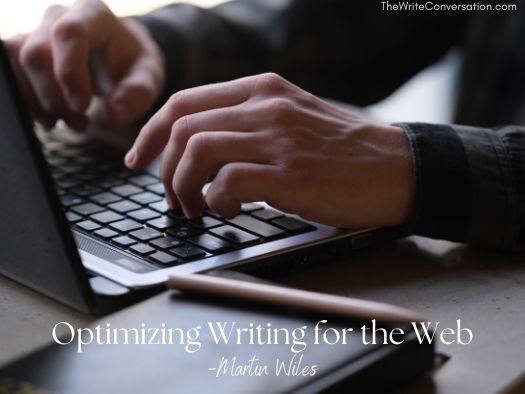
by Martin Wiles @LinesFromGod
I noticed the acronym SEO when I started using a program to manage a friend's website. But what did it mean? I soon discovered that optimizing writing for the web is critical if we want people to see what we write, which stands to reason if we put it on the web.
I decided to research the acronym and discovered it stands for search engine optimization. I knew what a search engine was and that optimizing meant making something the best it could be for its intended purpose. But what did that have to do with writing a post?
Sure, some of our writing entails self-catharsis, but we want others to benefit from it, too, especially if it somehow relates to promoting God’s kingdom. However, we must ensure a few things exist for prime optimization.
A Checklist to Optimize Your Writing for the Internet
WATCH THE TITLE
Our post's title should reflect the writing's theme and ideally should be found in the first paragraph and at least two to three other spots in the writing. (Note that my title is in the first paragraph.)
WATCH SENTENCE LENGTH
Shorter sentences are ideal—twenty words or less. At the same time, we don’t want our shorter sentences to sound like choppy first-grade writing, so we must write them smoothly.
WATCH CONSECUTIVE SENTENCES
We should have no more than two consecutive sentences that begin with the same structure.
WATCH THE THERES, HERES, AND ITS
When possible, avoid beginning sentences with there, here, or it—often followed by a form of the verb be (am, is, are, was, were, be, being, been). This structure makes for weak sentences.
WATCH THAT PASSIVE VOICE
This is a biggie. When possible, avoid passive voice. Let the subject do the action. “John ate the cake” is always better than “The cake was eaten by John.”
WATCH THOSE TRANSITIONAL WORDS
Paragraphs—and perhaps sentences within paragraphs—need transitional words so that one sentence flows smoothly into the following sentence and one paragraph transitions well into the next.
WATCH THOSE SCANNABLES
Finally, our writing will benefit from bullet points or all-caps headings. We live busy lives, and many readers scan rather than read every word in a post.
When the above is in order, the SEO analyzer will give a green light, meaning a search engine will more easily discover the writing—a good thing for us writers.
Now to Paul, who said, “Work willingly at whatever you do, as though you were working for the Lord rather than for people” (Colossians 3:23 NLT).
As Christ-followers, we, too, should optimize ourselves to do our best at living for Christ and doing his work, of which writing might be a part. Paul says to work willingly at what we do, whatever that might be. But how?
Jesus encapsulates the answer in his two greatest commandments: love God fully and others sacrificially. Loving God entails preparing ourselves for holy living because God requires this. Sin offends him. Disciples strive to live holy lives that reflect the nature of our heavenly Father. Loving others means overlooking many imperfections and seeing them as valuable because God created them in his image.
Holiness should be the theme of our lives, but we should not be so consecutive as to be legalists. We should avoid some things and always be active in God’s work. Additionally, we should easily transition from one life event to another without discouragement or depression because we know God controls our lives and will work all things together for our good and his glory. As people scan our lives, they should see moral living that reflects God’s character.
Now, think of what would help you optimize your life and writing so you can offer God your best.
Click to TweetOptimizing Writing for the Web from Martin Wiles (@LinesFromGod) on @EdieMelson (Click to Tweet)
 Martin Wiles lives in Greenwood, SC, and is the founder of Love Lines from God. He is a freelance editor, English teacher, pastor, and author. He serves as Managing Editor for both Christian Devotions and Vinewords.net and is an instructor for the Christian PEN (professional editor’s network). Wiles is a multi-published author. His most recent book, Hurt, Hope and Healing: 52 Devotions That Will Lead to Spiritual Health, is available on Amazon. He and his wife are parents of two and grandparents of seven. He can be contacted at mandmwiles@gmail.com.
Martin Wiles lives in Greenwood, SC, and is the founder of Love Lines from God. He is a freelance editor, English teacher, pastor, and author. He serves as Managing Editor for both Christian Devotions and Vinewords.net and is an instructor for the Christian PEN (professional editor’s network). Wiles is a multi-published author. His most recent book, Hurt, Hope and Healing: 52 Devotions That Will Lead to Spiritual Health, is available on Amazon. He and his wife are parents of two and grandparents of seven. He can be contacted at mandmwiles@gmail.com.
Published on May 10, 2025 22:00
May 9, 2025
You Need to Remember Your Unique Writing Journey

by Beth Vogt @BethVogt
“Life is a story. What does yours say?” ~Unknown
I read through the Bible last month.
Yes, you read that sentence correctly: I read from Genesis 1:1 to Revelation 22:21 in 30 days.
My dear friend (and our brilliant leader here at The Write Conversation), Edie Melson, inspired me to do this. When Edie mentioned she was reading through the Bible in April, I applauded her plan. Then God nudged me in a “You do it too, Beth” kind of way. I ignored the first nudge—but not the second.
You’re probably wondering, “What’s the point, Beth?”
I promise this post applies to our writing lives.
One of things I noticed as I read through both the Old Testament and New Testament—and most of April was spent in the Old Testament—was how often the prophets retold the Israelites’ history. Remembered what has happened. Remembered who God is. Remembered the people’s choices, both the good and the not-so-good, and the consequences of their actions.
We need to remember, my friends.
We’re writers. We know the importance of story. And yet, how often do we take the time to remember our story, the specifics of our writing journey, and learn from it?
I talked with a friend just the other day and we both admitted our journey along the writing road has looked nothing like we’ve expected. (Anyone else nodding their heads?)
For me, there have been unexpected bends in the road. Unexpected moments where God clearly said, “We’re going this way now, Beth” —and I had to hurry and catch up with where God was leading.
There have been successes. Contracts. Awards.
There have been disappointments. Times when I’ve asked God, “Really? This?” And even times when I’ve asked, “Really? This again?”
The important thing—possibly the most important thing—is to take the time to remember my writing story. To see my good choices. To acknowledge my mistakes. To see God’s leading. To see his provision.
Remembering will help me stay close to God as he leads me in the future.What about you? When did you stop writing long enough to remember your writing journey—how God has provided for you all along the way. Consider these questions to help you begin. You could even set aside time to journal your answers.
Questions to ask yourself about your writing journeyHow did God lead you in your early years as a writer? (Any specific Bible verses?)What lessons have you learned in the past year?What successes have you had as a writer?What disappointments have you faced?How has God surprised you along the writing road?How has your writing motivation changed since you first started writing?
Click to TweetYou Need to Remember Your Unique Writing Journey from @BethVogt on @EdieMelson (Click to Tweet)
 Beth K. Vogt believes God’s best often waits behind the doors marked “Never.” She’s authored 15 novels and novellas, both contemporary romance and women’s fiction. Beth is a Christy Award winner, an ACFW Carol Award winner, and a RITA® finalist. Her newest contemporary romance novel, Dedicated to the One I Love, released June 20, 2023. Her novel Things I Never Told You, book one in her Thatcher Sisters Series by Tyndale House Publishers, won the 2019 AWSA Golden Scroll Award for Contemporary Novel of the Year. An established magazine writer and former editor of the leadership magazine for MOPS International, Beth blogs for Learn How to Write a Novel and The Write Conversation and also enjoys speaking to writers group and mentoring other writers. She lives in Colorado with her husband Rob, who has adjusted to discussing the lives of imaginary people. Connect with Beth at BETHVOGT.COM.
Beth K. Vogt believes God’s best often waits behind the doors marked “Never.” She’s authored 15 novels and novellas, both contemporary romance and women’s fiction. Beth is a Christy Award winner, an ACFW Carol Award winner, and a RITA® finalist. Her newest contemporary romance novel, Dedicated to the One I Love, released June 20, 2023. Her novel Things I Never Told You, book one in her Thatcher Sisters Series by Tyndale House Publishers, won the 2019 AWSA Golden Scroll Award for Contemporary Novel of the Year. An established magazine writer and former editor of the leadership magazine for MOPS International, Beth blogs for Learn How to Write a Novel and The Write Conversation and also enjoys speaking to writers group and mentoring other writers. She lives in Colorado with her husband Rob, who has adjusted to discussing the lives of imaginary people. Connect with Beth at BETHVOGT.COM.
Published on May 09, 2025 22:00
May 8, 2025
A Post Conference Checklist: Five Things to Do After a Writing Conference
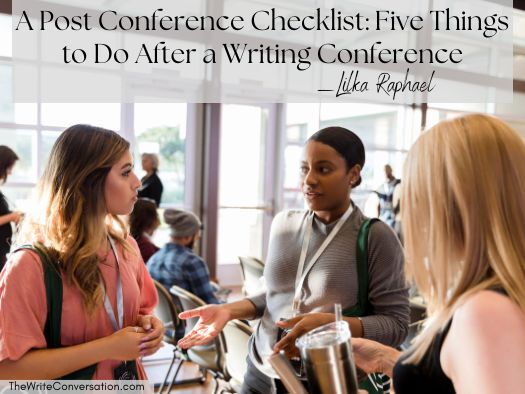
by Lilka Raphael @Lilka_Raphael
Writing is both intuition and trial and error, but mostly it’s very hard work—Cheryl Strayed
The exhilaration of a writing conference can quickly morph into mental chaos. The onslaught of information, ideas, and prospective leads drain even accomplished attendees. Once the conference has ended, now what?
Do These 5 Things After a Writing Conference
Get Some RestYou don’t want to follow up with the people you’ve met while you are delirious. Allow your mind to settle. Allocate time to reflect on and pray about what you learned. Then you can thoughtfully evaluate newfound opportunities and determine if they will work for you.
Follow UpSend appropriate thank you notes to the editors, agents, or publishers you met within a week. Thank them for their time, ideas, or direction. It doesn’t have to be long but do make it personal and sincere. A succinct note or email will do. Your professionalism may elevate you above the crowd.
An “it was nice meeting you” via email, social media, or shared contact information is suitable for other people you met. This is a wonderful way to make new friends, stay connected, and build your writing community.
Organize Your ThoughtsOnce your mind is clear, prioritize the information you gained. Review and rewrite any notes while they are legible. Analyze the critiques or feedback you received. Outline a list accordingly. Your now section may dictate that you immediately update your social media accounts. Tasks designated for later may feature investigating online writing sites or submission guidelines. Contacting book launch teams may be relegated for next year after your manuscript is complete. A visual timeline for ideas and tasks keeps everything you learned in the forefront and inspires you to stay on track.
Submit ItIf an agent or editor requested an excerpt or proposal, send it. But only after you have edited your work as best you can. If possible, have someone proof the draft before you hit send. Direct access to agents and publishers drives attendance at most conferences. Set a realistic but prompt deadline to complete this task.
Procrastination smothers opportunity. Don’t allow doubt to discourage you. Even rejection letters provide helpful insight that can improve your work. Remember to include the name of the conference where you met for a quicker response. Place this information in the subject line of your email. This is how many professional relationships begin.
Plan ItFinally, make plans for next year. If the conference was especially helpful, mark your calendar to attend again. Alternatively, if the conference didn’t provide everything you need, begin researching those that will. All conferences have their pros and cons. A romance author may not find much value in a Thrillers and Killers venue. Diligently scrutinizing the faculty, courses, and attendee feedback of several options can make your next conference your best conference.
Commit to the Lord whatever you do, and he will establish your plans. Proverbs 16:3 NIV
Click to TweetA Post Conference Checklist: Five Things to Do After a Writing Conference from @Lilka_Raphael on @edieMelson (Click to Tweet)
 A Florida native, Lilka Finley Raphael has been a licensed pharmacist for over thirty years. Her passions for writing, gardening, and photography prompted her to share her experiences and life lessons on her blogs B Is for Blessed and God, autism, & me. You can learn more about her at lilkaraphael.com
A Florida native, Lilka Finley Raphael has been a licensed pharmacist for over thirty years. Her passions for writing, gardening, and photography prompted her to share her experiences and life lessons on her blogs B Is for Blessed and God, autism, & me. You can learn more about her at lilkaraphael.comLilka’s greatest achievements are her two adult sons who have flown the nest. Happily married for thirty-two years, she lives east of Atlanta with her husband, Rod. They now share their home with two German Shepherds—Holly and Ivy—and one naughty kitty, Moxie.
Published on May 08, 2025 22:00
May 7, 2025
Seize the Opportunity to Meet New Friends at a Writing Conference

by Julie Lavender @JLavenderWrites
Are you ready for the Blue Ridge Mountains Christian Writers Conference? It’s just around the corner – mere days away. By now, you’ve pondered what to wear, picked out matching accessories, prepared one sheets, perfected your pitch, and prioritized classes. You’re organized, put-together, and acting wisely prior to the conference.
Sounds like a great strategy and one I’ve enacted may times before a conference. But, can I make a suggestion? Don’t get so busy with publishing agendas that you miss out on the opportunity to make lifelong friends while there. Don’t overlook the unplanned moments at a conference. Some even call them God-ordained appointments!
Some of my dearest writing friends now are those I met in seemingly-random fashion between one-on-one appointments, lectures, and keynote speakers. Here are some of my tips for seizing unexpected opportunities to find friends you’ll treasure for a long time.
Tips for Forging New Relationships at a Writing Conference
Ignore your introvert vibeLet’s face it—many of us writers are introverts. (I know, many of you aren’t! And I admire that.) For just the few days while at the conference, make an exception and snitch any opportunity to talk with fellow writers. Two of my good friends met while standing in the dinner line. You know, that time when you really just want to close out all the noise around you and think about that editor you’re meeting with tomorrow? Chat in line about writing goals, dreams, and accomplishments, children, pets, unique hobbies, and who lives in the coolest state.
Connect with someone on a similar writing journey as youMake a connection with someone in the continuing session you’re attending. If you’ve both picked that subject to learn more about, then you already have something in common. One of my dearest writing friends approached me during a continuing session, after I’d asked a question she could relate to in her writing journey. We formed a bond that’s grown over the years made possible by social media, email, and texting.
Be ready to serve othersAnother friendship began when I loaned a pen to an attendee, which turned into a conversation about my love of pens. In fact .. it’s more like an obsession with pens that borders on a syndrome that might need intervention. You know how they say admitting the problem is the first part of the battle, right? Well, I’m quick to recognize that I’m a kleptoPENiac. I won’t say that I actually just outright steal a pen .. but I have been known to make two circles around a floorshow to make sure I’ve collected more than one pen from each booth! Plan ahead to serve others – carry extra pens and mints, stop to assist the first-timer who looks lost, or hold the elevator door for the person laden with paraphernalia.
Join someone sitting alone Many conference attendees arrive not knowing even one other person on the campus. Keep your eyes open for someone dining alone or sitting alone in big-group sessions. You just might be surprised how much you have in common. Or even better, you might be more surprised to find out how very different you are, and that can make for a really intriguing relationship.
Worship with someone new
I’m a creature of habit—are you? I sit in the same pew every Sunday; I park on the same row at Walmart for every shopping trip, and I sit in the same chair at my mom’s for our large-family gatherings. But whenever I attend writing conferences, I enjoy choosing different spots of the auditorium for worship and keynotes. This gives me a chance to meet other people, the ones who sit in the same spot every night of the conference, LOL.
Get to know your roomieMany of you probably picked your roommate before signing up for the conference. Some may wind up with a random roomie you don’t know. However, if you’re like me, the words “random” and “coincidence” aren’t words you use often in God’s kingdom. I once got paired with a roommate many years ago at a conference out west that seemed on the surface to be a total mismatch. We differed in more ways than commonalities. Yet that first night, after talking until the wee hours of the morning, the two of us became dear friends and our relationship eventually turned into a professional one when we wrote together for a Denver newspaper.
You probably have great tips to capitalize unplanned moments, too. Join the conversation and share some of your ideas for meeting new friends at an upcoming conference. Or share a fun story about meeting that dear writing friend in one of those God-ordained appointments. I look forward to hearing your tips and stories.
Click to TweetSeize the Opportunity to Meet New Friends at a Writing Conference from @JLavenderWrites on @EdieMelson (Click to Tweet)
 Julie Lavender loves the friends she’s met over the years at writers conferences and looks forward to connecting with many of them in just a couple of weeks at Ridgecrest. Julie is the author, with her husband David, of the new book, Raising Good Sons: Christian Parenting Principles for Nurturing Boys of Faith and Character.
Julie Lavender loves the friends she’s met over the years at writers conferences and looks forward to connecting with many of them in just a couple of weeks at Ridgecrest. Julie is the author, with her husband David, of the new book, Raising Good Sons: Christian Parenting Principles for Nurturing Boys of Faith and Character.
Published on May 07, 2025 22:00
May 6, 2025
Learning to Set the Stage with Description in Your Manuscript
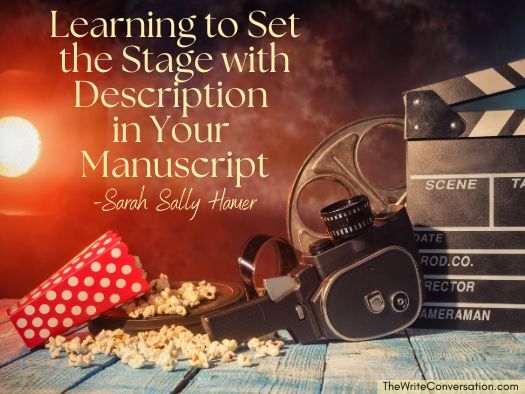
by Sarah Sally Hamer @SarahSallyHamer
How often do you get lost during a scene change in a book? You’re reading along, minding your own business, enjoying the story. Check. You come to the conclusion of a great chapter and/or scene. Check. Good ending, with a cliffhanger that leaves you panting to turn the page and start the next section. Check.
Then the books goes off to Oz. Or to Mars. Or to somewhere with someone with something going on that has NOTHING to do with what we just read.
Great. Lost. Close book. Turn off light. Go to sleep.
Not what we writers want to happen!
So, how do we fix the problem? By orienting our reader with what’s going on.
Setting the Scene
You turn the page to a fresh chapter and confusion immediately ensues. Who is speaking? Where are we? What’s going on and why are we in a completely different place and/or time? Readers rely on clear orientation when entering new chapters and scenes to avoid feeling like they’ve stumbled into chaos. But orienting a reader doesn’t mean dumping a dry block of exposition—it’s an art, a balancing act, and a perfect opportunity to sprinkle in some narrative magic. How can you pull it off? With flair, humor, and just the right dose of intrigue.
Anchor Your Reader in Time and Place
First things first—don’t leave your reader floating. Instead, weave your setting into the action or dialogue. Establish the where and when of your scene as soon as possible (read: in the first paragraph and even in the first sentence). Did the setting change from the last chapter? If so, where is the new one? If it’s in a different place, we need to know it immediately. You do NOT have to give a huge amount of information. In fact, it’s okay to simply use a tag with “Paris, 1935” to show us both where and when. You can also use dialog or a quick description. I recommend this come from your point of view character, SHOWING us what happened instead of TELLING us. A line like, “The neon sign above the bar flickered as Rosie poured herself another whiskey,” immediately sets up us to know where we are.
WHEN can be done the same way. “Two weeks later” or “She ached from head to toe. The horse the soldiers had chosen for her trip from Braemer to Dunsbury must have one leg shorter than the other three.” The latter one gives you an opportunity to add a tiny bit of characterization, a bonus!
Reintroduce Characters: The WHO of it
If you’re writing a sprawling cast of characters, chances are your reader isn’t going to remember every detail about a character and their situation, especially in a long book. Help them out. This doesn’t mean regurgitating their entire biography at the start of each chapter. Instead, offer light reminders through context or action. For example: “Damia tugged at the cloak, attempting to make it large enough to tuck under her legs. But the shaking of her body wasn’t just about the cold. Instead, her nemesis, her master, waited for her on the other side of the door." This reminds us who she is and why she is there—and hints at the coming conflict/tension, too.
Set the Tone
Tone is your secret weapon for orienting readers and creating emotional impact. Is the scene tragic, suspenseful, or laugh-out-loud funny? Readers should feel the mood shift as soon as they step into the narrative. So, since you’ve left them on a cliff-hanger for one section of the story, now is the time to change over to another puzzle piece. Some of us remember the Star Wars: The Empire Strikes Back. It’s the second movie in the original trilogy. Luke goes off on his own to work with Yoda and Han, Leia, Chewbacca, and C3PO take off in a different direction. The Luke/Yoda side of the story is internalization, character growth, and, bluntly, boring. So, Lucas brilliantly leaves us with poor Luke trying to figure himself out and jumps us to the worm in the asteroid planning on eating the other heroes. One side’s tone is slow and riddled with deep introspection, while the other is the rousing adventure we expect from a Star Wars movie. The tones are so vastly different, it’s almost as if they are in different movies but, because Lucas plans them out so well—AND ORIENTS THE READER on both sides—it keeps us engrossed.
Trust Your Reader’s Imagination
Here’s the caveat. Some writers can get away without setting a scene. But, except in movies, which has a completely different set of rules, most of us cannot. Movies are able to use the camera to set a scene so, simply by watching, the audience can orient themselves. But, since our tools don’t include video, writers MUST make sure the reader, no matter how great their imagination, don’t get lost.
This doesn’t happen as much in shorter books set in a familiar place (American writers reading contemporary books in an American setting) but in a high fantasy, with dozens of characters and many complex locations, orientation may mean the difference between a book being read or put down without it being finished.
Orienting your readers at the start of each chapter or scene isn’t just a necessity—it’s an opportunity to enchant, surprise, and pull them deeper into your narrative world. Paint the scene with precision, guide them gently, and then let their imaginations run wild.
Click to TweetLearning to Set the Stage with Description in Your Manuscript from @SarahSallyHamer on @EdieMelson (Click to Tweet)
 Sarah (Sally) Hamer, B.S., MLA, is a lover of books, a teacher of writers, and a believer in a good story. Most of all, she is eternally fascinated by people and how they 'tick'. She’s passionate about helping people tell their own stories and has won awards at both local and national levels, including two Golden Heart finals.
Sarah (Sally) Hamer, B.S., MLA, is a lover of books, a teacher of writers, and a believer in a good story. Most of all, she is eternally fascinated by people and how they 'tick'. She’s passionate about helping people tell their own stories and has won awards at both local and national levels, including two Golden Heart finals.A teacher of memoir, beginning and advanced creative fiction writing, and screenwriting at Louisiana State University in Shreveport for over twenty years, she also teaches online for Margie Lawson at www.margielawson.com and for the No Stress Writing Academy at https://www.worldanvil.com/w/classes-.... Sally is a free-lance editor and book coach, with many of her students and clients becoming successful, award-winning authors.
You can find her at info@mindpotential.org
Published on May 06, 2025 22:00
May 5, 2025
Fourth Person May Be The Least Used POV
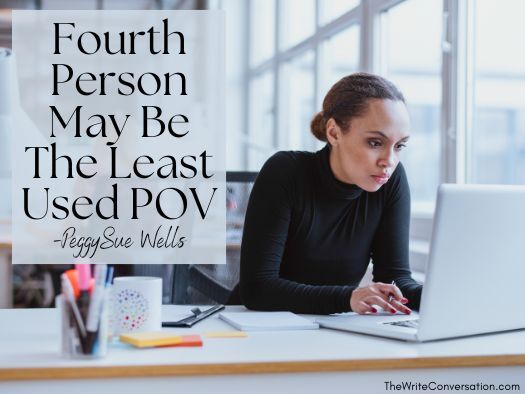
by PeggySue Wells @PeggySueWells
Fourth Person POV is characterized by the pronouns Anyone, Anybody, One, One's, Oneself, Somebody, and Someone.
In the commercial industry of professional writing, Fourth Person may be the least used point of view. This POV does little to assign responsibility or ownership for actions, opinions, or possessions.
Fourth Person POV is often labeled as First Person Plural. Both viewpoints are based in a collective. For instance, some readers categorize the novel Half by Sharon Harringan as First Person Plural and others place the story of twins as Fourth Person.
More passive than active, Fourth Person POV is difficult to use for a lengthy story. Instead, this style is more often found in short projects, how-to guidelines, and generalized explanations, instructions, and observations.
Fourth Person Examples for WritersAnyone can learn to play this game.Invite anybody to join the fun.One will quickly appreciate the beauty of the great outdoors.One's future and possibilities are as unlimited as the sun.This music is uplifting for others and encouraging for oneself.Somebody should take advantage of this opportunity before it goes away.These skateboards are ready to be ridden by someone.
William Faulkner used Fourth Person POV when he wrote A Rose for Emily. Similarly, Virgin Suicides by Jeffrey Eugenides is penned in Fourth Person POV.
While not the most used tool in a writer's POV toolbox, Fourth Person POV is available for the right project.
Click to TweetFourth Person May Be The Least Used POV from @PeggySueWells on @EdieMelson (Click to Tweet)
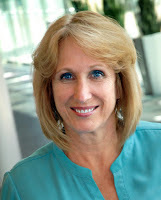 PeggySue Wells is the award-winning USA Today and Wall Street Journal bestselling author of 45 books including the mystery suspense title of the year, Unnatural Cause.
PeggySue Wells is the award-winning USA Today and Wall Street Journal bestselling author of 45 books including the mystery suspense title of the year, Unnatural Cause. Action and adventure, romantic suspense, military romance, and cozy mystery are the page-turning novels by P.S. Wells including Chasing Sunrise, Homeless for the Holidays, and The Patent. How to live better, easier, and simpler is the focus of her nonfiction including The Ten Best Decisions A Single Mom Can Make.
PeggySue is a frequent guest with media including Focus On The Family, Family Life Today, and Christian Product Expo. She regularly teaches at conferences including Write To Publish, Taylor University Writers Conference, Kentucky Christian Writers Conference, and the Advanced Writers and Speakers Association. Collaborator on multiple titles including books with Dr. Benjamin Hardy, Shemane Nugent, Pat Palau, and Pam Farrel, PeggySue is a writing coach. When not writing, she parasails, skydives, snorkels, scuba dives, rides horses, and has taken (but not passed) pilot training. Founder of SingleMomCircle.com, connect with PS Wells at WWW.PEGGYSUEWELLS.COM, on Facebook at PeggySue Wells, and LinkedIn at LINKEDIN.COM/IN/PEGGYSUEWELLS
Published on May 05, 2025 22:00



